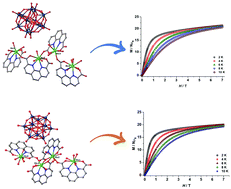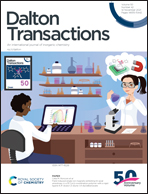Single-molecule magnets within polyoxometalate-based frameworks†
Abstract
As an extension of our interest in polyoxometalates (POMs) and lanthanoids, we report the design and synthesis of two polyoxometalate-based frameworks under hydrothermal conditions; [Ho4(PDA)4(H2O)11][(SiO4)@W12O36]·8H2O (1) and [Tb4(PDA)4(H2O)12][(SiO4)@W12O36]·4H2O (2) (H2PDA = 1,10-phenanthroline-2,9-dicarboxylic acid). Both hybrids have been characterized by elemental analysis, Fourier transform infrared spectroscopy, thermogravimetric analysis, and powder/single-crystal X-ray diffraction. According to the structural analysis, 1 and 2 consist of 2D-cationic coordination polymers based on the respective lanthanoids and PDA2− as well as Keggin anions that reside in the interspaces between two adjacent layers as discrete counterions connected by extensive hydrogen bonding. Although the overall structures of 1 and 2 are composed of cationic and anionic layers, there are many differences in the cationic layers such as various coordination modes of PDA2−, different void shapes, and the existence of dinuclear Tb(III) units only in 2. Frameworks 1 and 2 were further characterized by dc and ac magnetic measurements and both exhibit slow relaxation of magnetization at low temperatures under an applied dc field. Their single-molecule magnet (SMM) properties are investigated, where weak field-induced SMM behaviour is observed at low temperatures in dynamic magnetic studies.

- This article is part of the themed collection: Spotlight Collection: Lanthanide and transition metal complexes as molecular magnets


 Please wait while we load your content...
Please wait while we load your content...